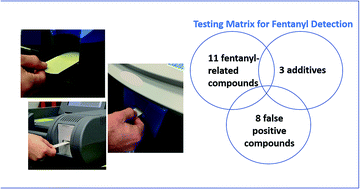Method for evaluating ion mobility spectrometers for trace detection of fentanyl and fentanyl-related substances†
Abstract
Continuing efforts to combat the opioid crisis in the U.S. require technologies that can detect the presence of fentanyl and fentanyl-related substances for multiple applications, including law enforcement and border protection. Ion mobility spectrometry (IMS) technologies have a potential role here, and agencies will require robust methods to evaluate instrument performance for what are very challenging detection requirements. A suite of commercial instruments configured for general drug and/or explosives detection was used to determine baseline performance for detection of fentanyl and 15 fentanyl-related substances to guide the development of a method. Detection of all 16 compounds and reproducibility in reduced mobilities (K0) of ±0.01 cm2 V−1 s−1 indicate that product ion formation is the same across instrument platforms, and a strong correlation with molecular weight (R2 = 0.99) allows for the prediction of reduced mobility for newly encountered fentanyl analogs. Eleven compounds representing those most frequently encountered in seized materials in the U.S. since 2015 were chosen for the proposed evaluation method. Based on the highest resolution instruments, detection windows of ±0.003 cm2 V−1 s−1 allow for 6 out of 11 compounds to be uniquely identified while the remainder are identified as pairs. The method proposes testing only 9 compounds because of the redundancies represented by the paired detections. Sensitivity measurements using ASTM E2677 for fentanyl and benzyl fentanyl indicate that all instruments are capable of nanogram detection levels, and that a common dosing level of 100 ng for all tested compounds is appropriate. Heroin, procaine, and quinine are proposed as confusants to add to fentanyl samples, based on the known presence of these materials in seized samples and baseline measurements of the effect on the detection of fentanyl. The method also includes a list of drugs that should be tested for false positives to ensure that authentic pharmaceutical compounds or other illicit drugs can be discriminated. IMS manufacturers are currently developing algorithms to enable fentanyl detection in their trace detectors, and this method can apply as those instruments become available.



 Please wait while we load your content...
Please wait while we load your content...